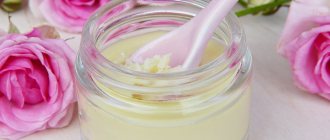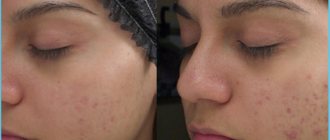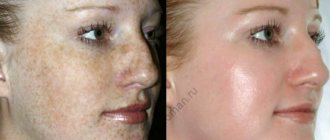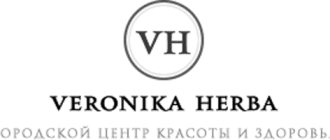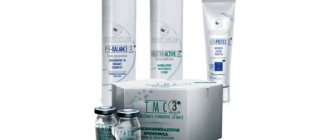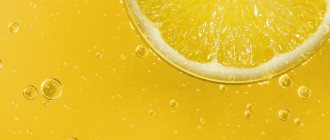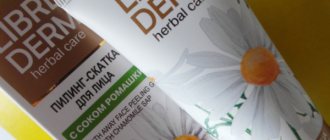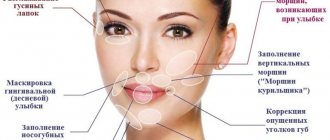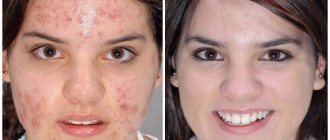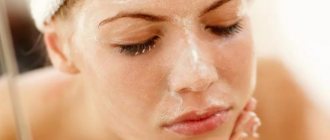The essence of the technique
TCA peeling is a method of chemical action on the skin.
TCA, or trichloroacetic acid, is a toxic substance and therefore requires a professional approach to use. Due to its ability to dissolve in water, it can penetrate deep into the layers of the dermis. It has a cauterizing, anti-inflammatory effect and fights bacteria well.
The compound is obtained by replacing the methyl group of acetic acid with three chlorine atoms. It is mainly used for laboratory purposes, but recently it has been used by cosmetologists to eliminate cosmetic defects.
Buyanov Sergey Yurievich (Expert Doctor):
Trichloroacetic acid is a rather dangerous compound, although it has a pleasant odor. In biochemistry, it is used to precipitate nucleic acids: DNA and RNA to prepare marker reagents for polymerase chain reaction (PCR).
Efficiency
The mechanism of action of the drug is absorption deep into the epidermis, as a result, the cell nucleus is destroyed due to protein coagulation and intercellular connections disintegrate, soft tissue particles die and, transforming into a stratum corneum, are exfoliated.
Additionally, micro-impurities located in enlarged pores and sebaceous plugs are removed. At the same time, restoration processes are launched through the division of new cells.
Effect of TCA on the skin:
- accelerates blood flow;
- activates neocollagenesis and elastin synthesis, thereby achieving a lifting effect;
- thanks to its powerful antioxidant properties, it blocks the activity of free radicals, as a result, the aging process is inhibited;
- minimizes pigmentation, eliminates freckles and acne spots;
- strengthens the immune system, protects against the effects of aggressive environmental factors;
- Compared to retinoic and glycolic peels, it has a stronger keratolytic property, due to which effective cleansing occurs and metabolic products are removed from the body.
Buyanov Sergey Yurievich (Expert Doctor):
In other words, the mechanism of action of acid peeling is a chemical burn, as a result of which regeneration mechanisms are launched at the cellular level. The more powerful the acid, the deeper the affected area.
Types of peeling
| Peeling type | TCA concentration | general characteristics |
| Surface | 5-15% | The composition can be supplemented with fruit acids and saponins. The components penetrate deeply into the epidermis and microcirculation is activated. |
| Median | 20-35% | Amino acids serve as auxiliary elements, promoting accelerated regeneration. It is used both to correct age-related deformities and to eliminate scars/stretch marks. |
| Deep | 40% | To soften the effect, the product is supplemented with saponins, phytic and fruit acids. Apply the drug pointwise to problem areas (For example, at the location of warts). |
Popular brands and prices
When going for a peel, be sure to ask what product the dermatologist works with. The Salicylicpeel JS solution from Martinex has very good reviews. It contains 10% lactic acid, 14% each of salicylic acid and resorcinol.
Other brands are no less popular:
- MedicControlPeel (MSP) Russia. The drug is not cheap; for 30 ml you will have to pay 4800 rubles;
- Allura (Allure) Esthetics USA— 2480 rub. for 30 ml;
- MedPeel USA - 2600 rub. for 30 ml;
- Mediderma (Mediderma) Spain - 7130 rub. for 60 ml;
- PCA Skin USA — 2840 rub. for 30 ml.
Recently, Kaitlin and ONmacabim from Israel have been gaining popularity . A tube of their product costs about 3,000 rubles.
Popular exfoliants
Skin Tech
Designed for use to achieve a noticeable anti-aging effect. The series includes three products.
- Easy TCA Peel - for surface cleaning. Contains lactic, salicylic, kojic, and glycolic acids as auxiliary components.
- UNIDEEP (23%) - for medium peeling. Used to smooth out pronounced wrinkles and minimize the symptoms of photoaging. Supplemented with saponins, ascorbic and citric acid.
- Only Touch Peel for cross -peeling - has a high concentration of active substance. The rest of the composition is identical to UNIDEEP.
Egia Ultra peel lotion
Italian peeling product to remove the stratum corneum and safely cleanse the skin.
Used as a preventive measure against the formation of wrinkles, as well as to give freshness to the skin.
The procedure has an accelerated recovery period and minimal risks of complications.
Can be used for any skin type and age. In addition to TCA, it will contain hydrolyzed oats, AHA acids (10%), lily and mimosa extracts.
PCA Sensi Peel
A more delicate product containing trichloroacetic acid at a concentration of 6%, supplemented with lactic and azelaic acids.
Acts exclusively on the stratum corneum of the dermis. Suitable for dry and sensitive skin.
Helps cure signs of rosacea, remove superficial wrinkles, and get rid of post-acne marks.
Enerpeel
Does not contain auxiliary components. Two exfoliants are available with a TCA ratio of 20% and 40%.
Used to eliminate hyperpigmentation and correct scars.
PRX T-33
All-season universal drug of a new generation. The composition also contains kojic acid and hydrogen peroxide.
Helps cope with age spots, wrinkles, stretch marks and scars.
TCA touch ph-formula
The product from the Cosmetic Group company is a hybrid complex of chloroacetic acid, arbutin and magnesium sulfate. The last component acts as a healing agent and metabolizer.
The action is aimed at leveling scars and signs of post-acne, eliminating signs of skin photoaging, and lightening pigmentation.
TCA 20% PH 0.5 ALLURA ESTHETICS
Designed for mid-level cleaning.
Stimulates intracellular regeneration and synthesis of collagen fibers. Has a powerful rejuvenating effect. Helps cope with the symptoms of photo- and bioaging, actinic keratosis, minimizes scars and stretch marks.
Dermaceutic Cosmo peel
Available in several variations with TCA ratios: 12%, 15%, 18% and 20%.
The drug with the highest pH value is intended for treatment in the periorbital and perioral areas with high sensitivity of the integument.
It does not cause complications, perfectly moisturizes, and has a rejuvenating effect.
Do not use if using yellow peeling based on retinoic acid.
TCAPeel 15% and 25%
Martinex exfoliation material is suitable for both superficial and medial correction. Helps cope with a wide range of problems, does not have a systemic effect, the intensity of the effect is characterized by the ability to control the process.
Jessner Peel Composition
The classic Jessner peel contains equal parts of salicylic and lactic acids and alcohol-based resorcinol:
- lactic acid - 14%;
- salicylic acid - 14%;
- resorcinol - 14%.
This is exactly the set of ingredients that Dr. Max Jessner proposed for his colleagues. This happened in the middle of the last century, and already in 1993 the composition was supplemented and improved by the president of PCA skin, Margeret Ansira.
Modified versions of the exfoliant do not contain resorcinol, are less toxic and are less likely to cause allergies. Therefore, women with dark or sensitive skin can use them.
To obtain a stronger exfoliating effect, the concentration of lactic acid in some preparations can be increased to 20% versus the standard 14%. Ethanol is used as a solvent.
Properties of lactic acid
The substance is an integral part of the epithelium, and when it gets on its surface in small quantities, it creates an acidic environment. This helps suppress the proliferation of pathogenic microorganisms and helps get rid of acne. In addition, lactic acid, an alpha hydroxy acid, has a mild exfoliating and whitening effect on the skin, moisturizes and stimulates the production of elastin and collagen.
Properties of salicylic acid
Salicylic acid is considered an excellent antiseptic. It quickly and actively softens the top layer of skin, improves exfoliation, dries and accelerates tissue regeneration.
The component is highly soluble in oil, so it is used to reduce sebum secretion and fight acne. The substance cleanses oily skin, frees pores from contents and narrows them, dries out inflammation, and eliminates itching.
Action of resorcinol
In medicine, resorcinol is used as a disinfectant and tanning agent in the treatment of skin diseases. The component has a pronounced antimicrobial effect and enhances the work of acids.
Thanks to the antiseptic, skin inflammation and irritation rarely occurs after Jessner peeling. Chemical burns heal quickly and completely, leaving no scars.
Jessner Peel with Hydroquinone
Exfoliants with a similar component are modified products and have a pronounced brightening and smoothing effect. Hydroquinone is considered a good antioxidant, but if used in excess, it can trigger the growth of cancer cells. Doctors warn that if quinol is applied too often, the opposite effect is possible - the skin will acquire a grayish tint and become covered with spots.
In Russia and European countries, cosmetics containing hydroquinone are prohibited. In the USA, the substance is approved for use in a concentration of no more than 2%.
Products with hydroquinone are suitable for women with thick, dense skin. On thin and sensitive epithelium, drugs can cause severe irritation.
Types of Jessner peeling
In most cases, Jessner peeling is used as a superficial procedure, but can also be used for a more serious - medium - effect. To understand the difference between them, let's look at each option in more detail:
- Superficial exfoliation. One layer of the drug is applied to the skin. The procedure is performed to moisturize the epidermis, smooth out the relief and reduce pores, or as a preparatory measure for a deeper effect. After exfoliation, slight peeling is observed for 2–3 days.
- Median exfoliation. The skin is covered with two or more layers of solution. In this case, the drug penetrates the entire level of the epidermis without reaching the basement membrane. The recovery period takes 5–6 days with more severe peeling. The method copes with expression wrinkles, post-acne, scars and pigmentation.
Sometimes peeling is carried out in 4-5 stages and is called deep. It is performed only in exceptional cases, since the procedure is quite traumatic and produces a pronounced vascular reaction with the effect of surface coagulation. Skin treated with this method will heal for at least 2 weeks.
The optimal type of exfoliation is selected individually by the cosmetologist and depends on the type of defects and the patient’s skin.
Indications for use
Jessner's chemical peel can solve many problems. This is why the Hollywood version is so loved by cosmetologists and patients.
Indications for the procedure:
- expression and age wrinkles;
- dark spots;
- acne;
- photoaging;
- dry and dehydrated skin;
- dermatological diseases (hyperkeratosis, rosacea);
- post-acne, scars and cicatrices;
- stretch marks and stretch marks;
- preparation for other cosmetic procedures (plasty, deep exfoliation, mesotherapy).
Exfoliation with acids not only rejuvenates the skin, but also acts as an excellent prevention of aging.
Contraindications for the procedure
Chemical exfoliation, even the lightest and most non-aggressive one, is a serious cosmetic procedure that has its limitations, and you should be aware of them.
Contraindications for Jessner peel:
- individual intolerance to exfoliant components;
- inflammation and trauma to the skin (rashes, abrasions, scratches, cracks);
- exacerbation of herpes;
- pregnancy and lactation;
- infectious processes occurring with fever;
- oncology.
It is not recommended to carry out the procedure for demodicosis - peeling can provoke a relapse, and the patient will have to undergo treatment for a long time.
A temporary contraindication to acid exfoliation should be the season of the year - exfoliation should not be carried out during periods of high solar activity. The best time for the procedure is from October to March.
In case of serious diseases of the liver, kidneys or heart, only superficial peeling should be used. In this case, the limiting point is resorcinol. With each additional layer, its toxic effect on the body increases, which can adversely affect people with chronic pathologies.
Technique
Chemical exfoliation is a quick and, at first glance, simple manipulation, but it requires the cosmetologist to have a lot of experience and good knowledge of the procedure protocol with a certain composition.
Step-by-step implementation of the Jessner peel:
- The session begins with cleansing the skin with special products with a neutral pH. After a minute, the composition is washed off and the face is treated with alcohol.
- The exfoliant is shaken and quickly applied with a cotton swab, starting from the forehead to the chin.
- After the peeling composition, according to the protocol, Aglycolic cream, Retises Forte or another drug and sunscreen are applied to the skin. This concludes the procedure.
If it is necessary to cover the skin in several layers, this is done 2-3 minutes after each previous one.
Please note that exfoliant is usually not washed off from the face in a beauty salon. You will remove it at home 6 to 12 hours after the procedure.
And one more important point - you should not leave the salon with uncovered peeling, that is, the face after exfoliation should be treated with special preparations.
Video: peeling procedure
Indications for use
The need for TCA peeling and the depth of impact are determined by the cosmetologist.
Using a chemical cleaning procedure, you can solve a number of problems, including:
- hyperkeratosis (atrophied compaction of the integument);
- photopigmentation;
- uneven skin texture;
- unhealthy complexion;
- wrinkles of varying severity;
- stretch marks;
- striae;
- birthmarks;
- post-traumatic scars;
- decreased dermal tone, sagging;
- acne;
- active production of sebaceous secretion;
- comedones, blockage of enlarged pores;
- Melasma.
Answers on questions
How many procedures are needed per course to achieve maximum effect and how often are they performed?
The duration of the course depends primarily on the composition of the exfoliant. The more aggressive the solution, the fewer procedures will be needed to achieve the effect, but the interval between them will increase.
For example, for sensitive skin, 4 sessions with a break of 7–10 days will be enough. To smooth out wrinkles or scars, you will need a more concentrated composition. In this case, only 2 sessions are performed with an interval of 2 weeks.
Can it be done during pregnancy?
In itself, skin exfoliation as a cosmetic way to improve appearance does not pose a threat to mother and child. It all depends on the composition of the drug and the depth of impact.
Doctors and cosmetologists are unanimous in their opinion - any medium and deep peelings are prohibited during pregnancy. Only superficial exfoliation with natural fruit acids is acceptable. Well, since Jessner’s solutions contain resorcinol and aggressive acids, they cannot be applied during pregnancy.
What is the best way to prepare for the procedure?
Typically, the protocol for an exfoliant indicates the need for pre-peeling. It should be started 3 weeks before the procedure.
There are several preparation options:
- Perform 2–3 superficial Jessner peels or almond peels;
- Daily use of products with fruit acids;
- Home care with retinol-based cosmetics.
All considered options smooth and thin the epidermis, which reduces the consumption of an expensive drug. In addition, pre-procedural preparation increases the rejection of scales, improves the final effect and reduces the risk of complications.
How is the Jessner peel different from the yellow peel?
The difference between the procedures is quite significant. Firstly, this is a set of ingredients. Retinoic or yellow composition contains many acids - retinoic, azelaic, phytic, ascorbic and kojic. Their action is much softer and more delicate compared to Jessner components.
Secondly, yellow peeling does not irritate the skin, peeling after it is less pronounced and goes away more evenly. This exfoliation option is most often prescribed for unclean, acne-prone facial skin. But retinoic acid also has one significant disadvantage - it, unlike Jessner’s composition, very often causes allergies. Therefore, women prone to unexpected reactions should use yellow peeling with caution.
Peeling
The procedure must be carried out by a qualified specialist - he will correctly calculate the degree of purification and the exposure time of the drug.
It is better to do peeling in the autumn-winter period, as it is characterized by the least sun activity. At other times, the risk of causing hyperpigmentation increases.
To prepare the skin for the upcoming correction, cosmetologists recommend:
- refuse to visit the sauna, bathhouse and solarium;
- hold off on cosmetic procedures such as eyebrow tattooing and hair removal in the upper lip area;
- Before going outside, apply cream with an SPF filter of 50.
- In about a month, stop using aggressive skincare products and replace them with preparations based on fruit acids.
5 days before the procedure you need to undergo antiviral medication therapy. to reduce the risk of herpes infection.
The specialist may also prescribe a course of medications whose action is aimed at strengthening blood vessels and capillaries. It is allowed to carry out peeling based on AHA acids 2 weeks before the session.
Protocol
1. Apply the product to cleansed skin using a flat brush (follow the massage lines). The number of layers is determined by the doctor, focusing on the individual characteristics of the client.
When performing a mid-peeling, pain relief is performed using a directed flow of cold air. For deep cases, local anesthesia is required.
Within a few minutes, the shade of the drug changes depending on the degree of penetration - from light pink to white. The latter is characteristic of the median correction.
2. Treat the surface with a neutralizer of the same brand as the exfoliant. If necessary, the cosmetologist additionally uses warm boiled water.
3. Apply a mask with regenerative and anti-inflammatory properties.
4. The skin is treated with sunscreen.
The course is recommended to be carried out only once a year. Otherwise, it will lead to skin depletion.
Healing period
In the first days after TCA peeling, swelling, severe redness and peeling appear, symptoms may increase. After 3-4 days, the treated surface begins to become covered with a crust (it cannot be removed!).
After 7 days, a noticeable improvement is observed - the swelling subsides, the itching goes away, and the stratum corneum gradually peels off.
The skin may peel off within 2 weeks. Full recovery takes about a month. At this time, mesotherapy or biorevitalization can be performed.
Skin care rules for the rehabilitation period:
- You can wash your face only after 3 days;
- It is not recommended to wear makeup;
- exclude alcohol, dairy products, fatty foods, green tea from the diet;
- It is forbidden to steam the skin, apply compresses, or use abrasive care products to speed up the exfoliation process;
- use sunscreen before going outside;
- as prescribed by a doctor, you can apply antiseptic and restorative ointments (in most cases Bepanten is prescribed);
- refuse to visit the sauna, solarium, swimming pool, gym;
- You should drink plenty of fluids to maintain the hydrobalance of the whole body.
Recommendations from cosmetologists for the procedure
Most women suffer from dry skin and flaking, which prevents them from doing basic everyday makeup. Cosmetologists know very well that the best exfoliating agent is peeling, which contains a combination of different components, i.e. GLS.
An experienced doctor is obliged to give a special solution with a small concentration of acid before the session, so that you can use it at home for a week and monitor the body’s reaction.
Even for the first procedure, cosmetologists recommend the use of GLS peeling, since, thanks to its composition (glycolic, salicylic and lactic acids), it produces a mild effect.
By reading reviews of Allura Esthetics products on the forums of professional cosmetologists, you can be convinced that the chemicals of this brand do not harm the skin and promote cleansing and rejuvenation.
With the help of a special neutralizer, the peeling composition is softened, and the redness goes away in less than a day. And having a water base, the neutralizer is quickly absorbed, restoring the pH of the skin.
Cosmetologists insist on the mandatory use of a neutralizer during procedures with glycolic acid.
Also, the Allura Esthetics line has restorative agents that doctors use after peeling.
Contraindications
- Pregnancy;
- Lactation period;
- Inflammatory processes and violation of the integrity of the integument in the corrected area;
- Herpes;
- Increased blood sugar levels;
- Fresh tan;
- Aggressive cosmetic procedures such as laser resurfacing and dermabrasion undergone the day before;
- Relapse of chronic diseases;
- Tendency to form atrophic scars;
- A large number of moles, warts, age spots;
- Papillomas;
- Oncology;
- Fungal diseases;
- Pathologies of the thyroid gland;
- Critical days;
- Cuperosis;
- Predisposition to an allergic reaction;
- Individual intolerance to the ingredients of the drug;
- Psychosomatic disorders;
- Taking vitamin A in large doses in the previous six months;
- Excessive hair growth in the target area.
Precautionary measures
To avoid complications, it is necessary to responsibly follow the cosmetologist’s recommendations regarding preparation and properly care for the skin during the rehabilitation period.
You should also not hide known contraindications from your doctor, which can cause serious undesirable consequences.
Side effects
After an acid peel, you may encounter a number of problems:
- herpes (occurs if a person is predisposed to this infection or if therapy with antiviral drugs is neglected until correction is carried out);
- persistent erythema (observed in a category of people with obvious signs of rosacea);
- hyperpigmentation (associated with the use of chemicals in the summer);
- acne;
- peeling;
- redness;
- swelling;
- “marbling” of the covers;
- demarcation line;
- increased sensitivity;
- allergies (to exclude this complication, it is necessary to conduct an allergy test in advance);
- scars (appear if the patient tore off the crust from the treated area).
Chemical peels Allura Esthetics (USA)
Allura Esthetics superficial acid peels presented on our website can be used on patients with any skin type according to the Fitzpatrick classification with good results. There are few contraindications. However, acid peels should not be used on patients with a history of dermatological disorders that manifest as skin sensitivity, on patients with a known sensitivity or allergy to any component of the peel substance, on patients who have unrealistic expectations and who are unfamiliar with home care treatments.
Carrying out at home
You can buy TCA peeling at an online pharmacy, but it is not recommended to carry out the procedure at home: a mistake can cause serious consequences, for example, severe peeling and burns.
If you have special education or experience, you can try to perform the correction yourself, but you will be responsible for the result.
Chronology:
- Cleanse the skin, degrease with tonic.
- Remove excess moisture with napkins.
- Distribute the product precisely using cotton swabs, avoiding contact with the mucous membrane of the eye.
- To reduce the burning sensation, you can direct a cold air hairdryer or fan to the correction area.
- After 3 minutes, neutralize the exfoliant with a weak soda solution.
- Wash your face with warm boiled water and apply a soothing mask.
What acid peels cannot do for your patients:
- Remove deep scars
- Remove dilated blood vessels
- Replace plastic surgery
What can the client expect?
Immediately after applying an acid peel, most people experience a brief burning sensation. It can be either minor or intense. Each patient is individual and each will have their own sensations. Using a fan or a special cooling mask during the procedure helps some patients feel more comfortable. After peeling, the patient may experience moderate redness and swelling for 6-24 hours after the procedure. Redness may persist until treatment is completed. Treatment may take up to 7 days and may cause mild to severe peeling depending on the acid used. A series of treatments may be required to achieve maximum results from this type of treatment. As a rule, one procedure will not help achieve the result that the patient wants to see.
What complications can you expect?
Complications after superficial peeling are rare. The most common side effect of peeling is prolonged redness, irritation and increased sensitivity. Pigmentation is less common. These side effects usually do not last long. It is strongly recommended that patients follow all prescribed home care regimens. This minimizes the potential risk of infection and maximizes the benefits of the procedure.
What products should I use after peeling?
To maximize the results of an acid peel (or series of peels), it is very important to apply special post-peel products that nourish and moisturize the skin. This must be done for 10 days immediately after the procedure.
Photos before and after
Cost of services in salons
Prices for TCA peeling are quite affordable: on average, from 2000 to 7000 rubles per session.
The final amount is influenced by the type of drug used, the area of influence, and the prestige of the clinic. The price tag may also vary relative to the development of the city’s infrastructure.
Ufa
| Name | Address | Price | telephone |
| MD Plus | st. Zhukova, 24/1 | from 2 000 | +7(347)216-15-15 |
| ProMedicine | st. Aurora, 18 | from 4 000 | +7(347)225-03-59 |
| MEDI | st. Batyrskaya, 8 | 3 000-4 500 | +7(347)216-41-03 |
| Paradise | st. R. Sorge, 11/1 | 2 800-3 400 | +7(347)287-05-75 |
Moscow
| Name | Address | Price | Telephone |
| CEM Dr. Shumskaya | st. Novoslobodskaya, 62, bldg. 15 | 4 600 | +7(495)924-56-84 |
| MARAFET | Leninsky Prospekt, 107, bldg. 3 | from 5 000 | +7(495)295-40-40 |
| Beauty salon “Studio-84” | st. Shabolovka, 22 | from 14 000 | +7(499)649-89-13 |
| Beauty laboratory “Practice” | Prospekt Mira, 102, st. thirty | 8 000 | +7(495)021-71-94 |
Sochi
| Name | Address | Price | Telephone |
| Clinic “Vale Aesthetics” | st. Gagarina, 16 | 4 000 | +7(862)225-61-87 |
| Beauty salon “Manhattan” | st. Gagarina, 54 | 5 000 | +7(918)906-85-65 |
| Angel Beauty | st. Golubaya, 1a | 3 500-4 500 | +7(988)235-54-54 |
Voronezh
| Name | Address | Price | Telephone |
| LLC “Cosmetology Center” | Moskovsky Prospekt, 33 | 3 800-5 500 | +7(473)261-07-47 |
| POSITIVE | st. Karla Marksa, 108/110 | from 2 800 | +7(473)252-62-22 |
| NATALIE | st. Plekhanovskaya, 42 | from 3 000 | +7(473)203-06-00 |
Stavropol
| Name | Address | Price | Telephone |
| Clinic “Solo” | st. Partizanskaya, 2 | from 3 300 | +7(8652)21-52-25 |
| Beauty salon “Family” | st. Rogozhnikova, 9 | 2 000 | +7(8652)99-70-50 |
Nizhny Novgorod
| Name | Address | Price | Telephone |
| Prime Beauty Clinic | st. m. Yamskaya, 18, building 3 | 5 000-7 000 | +7(831)469-01-11 |
| SPA salon “Bali” | st. M. Gorky, 52 | 3 500 | +7(831)231-08-09 |
| MANIFIC PLAZA | st. Varvarskaya, 6a | 3 600 | +7(831)219-91-74 |
Kirov
| Name | Address | Price | Telephone |
| Cosmetology Clinic “Aesthetic” | st. Vorovskogo, 71 | from 5 000 | +7(8332)67-05-57 |
| Workshop of innovative cosmetology | st. Lenina, 93 | from 2 000 | +7(8332)37-57-37 |
Opinion of cosmetologists
You can get a complete picture of TCA-based chemical peeling by studying various Internet sites where both patients and cosmetologists express their opinions about it in detail. One of such portals is Recommends.
Most experts note the high effectiveness of the procedure:
A practicing surgeon talks about precautions:
A professional talks about the effectiveness of peeling:
The second participant in the conversation agrees with his colleague:
The doctor compares Spanish TCA drugs with Medic Control:
